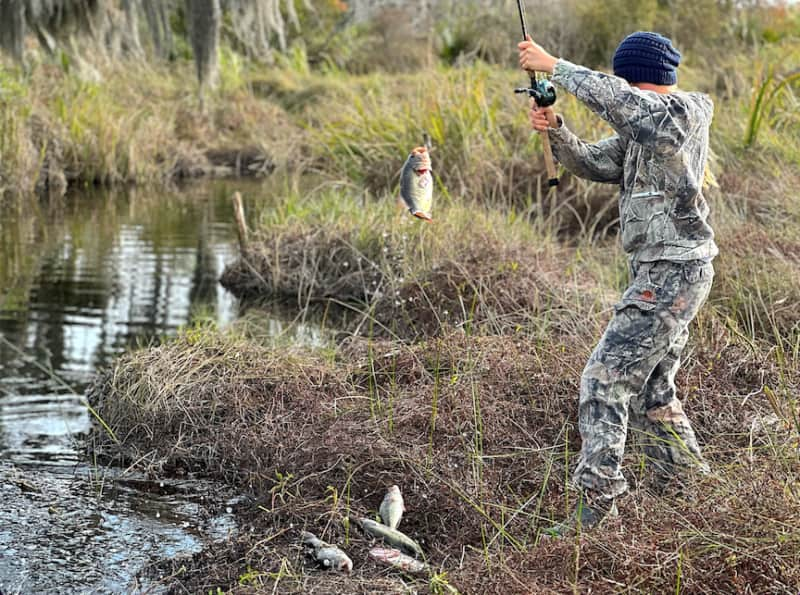Keith Lusher 02.08.24

I have to admit, there are months other than February that I prefer to fish for bass. Between the cold fronts blowing through and the frigid temperatures, this month has proven itself not to be an easy month when it comes to putting bass in the boat. But through the years I’ve learned that my trips in February have often been my best trips when it comes to finding bass stacked up in one location. I recently made a trip with my daughter Kasey to fish a shallow bayou just north of Lake Pontchartrain called Bayou Cane. This “Baby Bayou” stretches a little over a mile from it’s inception, to the point where it empties into the Lake.

At first glance the thought of fishing this bayou in 30-degree temperatures may seem nonsensical, but after trial and error I’ve learned to key in on the deep holes in the bayou. Because Cane is so shallow averaging 7 feet, the bass are forced to find the deepest water that is available.
As the bayou winds south there are numerous cuts that spill out of the marsh. The french word for these cuts is Trenasse which means a ditch dug in the marsh. What makes these ditches so special is their ability to create deep holes in the main bayou over years of marsh drain. While the average depth of Bayou Cane is 7 feet, the holes created by these trenasse’s are over 12 feet which makes it a magnet for bass seeking deeper water.
We started out day at the mouth of one of these trenasses using black and blue Rattling Football Jigs made by Delta Lures. We both were fishing with out freshwater spinning reel set-ups which has 8 lb. test loaded on the spool. The water in Bayou Cane was extremely clean on this day so I made sure that both Kasey and I were using thin line so it wound’t be easily seen by the fish.

The day started out a bit slow and after Kasey missed three fish, I decided to I decided to make a move down the bayou to find a better bite. Kasey argued that we should stay put because she was getting bites so she suggested I let her out to fish from land. Bayou Cane is normally fully inundated with alligators but with it being winter, the gators were still hibernating so I decided to let her out in the marsh so that she could continue to fish the deep hole. I spotted a matted down section of marsh grass along the shoreline and decided to let her out there. The ironic thing about this spot is that I was a bedding area for alligators over the summer but with the gators gone, it made for the perfect spot for her to fish without being bothered by marsh grass.
After dropping her off on land I made my way south to the next trenasse where I found an 11-foot hole in the main bayou. I started casting my jig and on the third cast felt a bump and set the hook on a 14-inch healthy marsh bass. On my very next cast I repeated the performance and I then remembered why I loved fishing this shallow bayou in the winter. The bass so so stacked up in the hole that I was able to put a limit of 10 bass in the ice chest within an hour.
After the tenth bass hit the ice I circled back to check on Kasey. My plan was to pick her up and bring her back to my spot so that she could catch her 10 but the plan was ruined when as I approached I watched as she put three bass on the bank. As I got closer I was a total of five on the bank. She told me to hold back so I wouldn’t disturb the spot and it didn’t take her long to finish of her limit. On our ride back to the launch Kasey explained that she started catching fish when she slowed down her retrieve. “Sometimes the bass would pick it up when It was still and just lying on the bottom,” she said. After the small adjustment Kasey said it was non stop action. “I basically slowed everything down and watched my line for movement. When that line started moving left or right, I set the hook and brought him ashore,” she said.

It’s true that bass fishing in February has it’s challenges, but using the freezing temperatures to your advantage can pay dividends if you can find deep holes in a relatively shallow tributary like Bayou Cane. A few extra feet of water can provide these bass with warmer water on the bottom and it’s this water that can make a cold raw day in February one of your most memorable trips!

